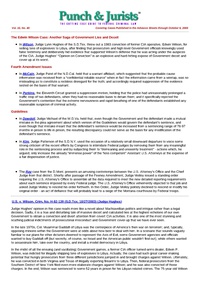Here Judge Molloy refused a Government request to reconsider a standing order that required the U.S. Attorney's office in Montana to assemble the data required to comply with the court's reporting requirements under the Feeney Amendment.
When Congress recently enacted the Feeney Amendment ad part of the PROTECT Act, it ...
Here a divided panel rejected a Batson challenge by the defense, holding that the Equal Protection Clause did not bar the Government from using peremptory challenges to remove two potential jurors based on religious beliefs and heightened religious involvement. The split court did not, however, decide whether a peremptory strike ...
The Court held that even though the parties made a mutual mistake about which Guideline version applied (resulting in a huge sentence icrease), the defendant was not entitled to any relief since he had been told the ahreement was not binding on the Court.
This case focuses attention on two ...
Here the Court held that a warrant affidavit, which suggested that the probable cause information was received from a “confidential reliable source” when it actually came from a wiretap was so misleading as to be a reckless disregard for the truth.
The defendant in this case, Aisha McCain, was charged ...
In October, 2002, Steven Kim, a 57-year old naturalized citizen from Korea traveled to New York from his home in Illinois to draw attention to the suffering of the North Korean people. He went to the United Nations, jumped the fence, and fired several rounds of bullets from his revolver ...
The plaintiff-arrestee in this case brought an action against two defendant police officers under 42 U.S.C. § 1983, alleging excessive use of force. A jury found in favor of the arrestee and awarded him one dollar in nominal damages. The arrestee brought a motion to Fed. R. Civ. P. 59 ...
In this case, citing the provisions of Rule 23(b) of the Fed.R.Crim.P., a divided panel held that the district court had committed structural error, requiring reversal without any showing of prejudice, by permitting, over the defendant’s objection, the trial to continue and the verdict to be rendered by only 11 ...
Here, as an issue of first impression for the Ninth Circuit, the Court joined with nine other Circuits in holding that a trial court’s decision to empanel an anonymous jury is entitled to deference and is subject to an abuse of discretion review.
In its decision affirming the district court's ...
This case is noted for its timely review of the three different approaches taken by the federal courts on the question of whether a Rule 60(b) motion to vacate a judgment denying habeas relief is considered a second or successive habeas petition.
The petitioner in this case sought relief, pursuant ...
Here the Court vacated a 1983 conviction of former CIA operative, Edwin Wilson, for selling tons of explosives to Libya, after finding that prosecutors and high level Government officials knowingly used false testimony and hid exculpatory evidence.
Judge Hughes’ opinion in this case reads more like a novel about Machiavellian ...
Here the Court affirmed a suppression motion, holding that the police had unreasonably prolonged a traffic stop of two defendants, when they had no reasonable basis to detain them; and that extreme nervousness did not constitute probable cause.
In this case, the Government appealed from a district court order granting ...
